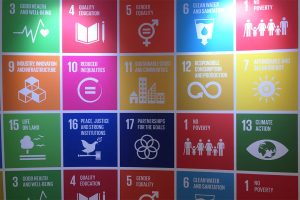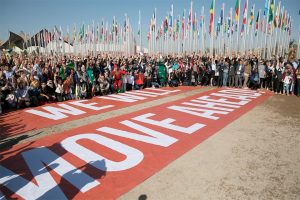The thirteenth goal of the Sustainable Development Goal (SDG) framework stands out from the other sixteen goals because it alone is followed by an asterisk. For this SDG, the international community agreed to “take urgent action to combat climate change and its impacts”, while “*acknowledging that the United Nations Framework Convention on Climate Change is the primary international, intergovernmental forum for negotiating the global response to climate change.”
Negotiations under UNFCCC auspices were well advanced on what became the Paris Agreement on climate change three months after the adoption of the SDGs. SDG negotiators decided not to preempt those discussions or wade into the climate change debate at the risk of derailing agreement on the rest of the SDGs. Nonetheless, throughout the negotiations on the SDGs, some delegates proposed integrating climate change issues into the other SDGs, rather than having a “stand-alone goal.” Ultimately, those who argued that an agenda for the 21st Century must feature climate action as a central focus prevailed, but the asterisk deferred to the UNFCCC role in driving change.
Two years into SDG implementation, where does SDG action on climate change stand? In our work on the SDG Knowledge Hub, we often see references that call for the implementation of both the SDGs and Paris Agreement, which highlights the interconnected but separate status of the global agendas adopted in September 2015 and December 2015, respectively. Increasingly, however, we have seen explicit identification of the links between the agendas.
In March 2017, for example, then President of the UN General Assembly, Peter Thomson, convened a High-Level Event on the theme, ‘Climate Change and the Sustainable Development Agenda,’ in collaboration with the UNFCCC Secretariat. Interest from UN member states was so high that a second day was added to the agenda, to accommodate all of the States that wanted to speak. As the facilitator of one of the panel sessions reported at the end of the first day, “participants quickly jumped into discussions regarding options to address climate change in a holistic manner, with all recognizing the linkages between the SDGs and climate change.”
Explicit links are now noted in some areas, including technical assistance on climate technologies provided to developing States by the Climate Technology Centre and Network (CTCN), the implementation arm of the UNFCCC Technology Mechanism. In addition to SDG 13, the CTCN highlights other Goals its active technical assistance helps advance. The process of naming the SDGs may appear superficial, but committing the 17 goal and 169 target model to memory, and then ensuring that our actions take the entire framework into account with each action, requires intentional reminders and repetition.
As we head into the 2017 session of the Conference of the Parties to the UNFCCC, we are seeing an increasing focus on joined up implementation for climate action and sustainable development. This theme is particularly in play with regard to the next generation of Nationally Determined Contributions (NDCs), and the role that integrated national planning can play in driving the shared objectives of the Paris Agreement and the SDGs. The CEO of SEforALL, Rachel Kyte, recently noted that country planning for achieving the SDGs and the NDCs is better than the previous generation of national plans, and that countries have been able to learn from their neighbors. She stressed the need for policy coherence in planning by all countries, however, if developing countries are to make progress.
In this light, in addition to the discussions at the Bonn Climate Change Conference, we will be watching the outcome from a meeting taking place right before the 23rd session of the Conference of the Parties (COP 23) to the UNFCCC. An Expert Group Meeting on the guidelines for Voluntary National Reviews (VNRs), which countries present to the High-level Political Forum on Sustainable Development (HLPF) to identify their SDG implementation efforts and planning, is being organized by the UN Department of Economic and Social Affairs (DESA), and will take place from 2-3 November, at the conclusion of the 2017 Sustainable Development Transition Forum, in Incheon, Republic of Korea. The more interlinkages and cross-cutting focus areas that can be built into the templates for both the NDCs and VNRs, the more focused countries will be on projects that integrate the objectives of the 2015 agendas.
We will be looking for how these linkages and agendas are joined up in the discussions at both of these meetings, and as the national planning processes under both the Paris Agreement and the 2030 Agenda evolve.


